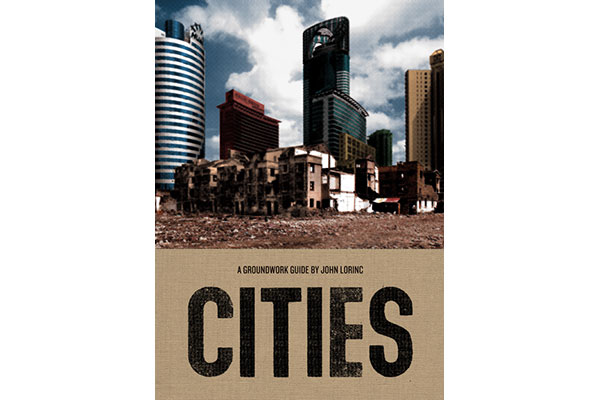
Author: John Lorinc (Groundwood Books/House of Anansi Press, 2008)
It is now common knowledge that the world is the most urban it has ever been in the history of humankind. With 2008 marking the pivotal moment when more people were living in cities than in rural location, our urban centers have been forced to engage this new condition and confront the many wonderful and frightening issues that this entails.
Given that such urban-related issues – ranging from ecology and urban design to economics and politics – are far from straightforward, attempts to summarize them are few and far between. Indeed, one may consider it a fools dream. But that is exactly what award-winning Toronto journalist John Lorinc has attempted to do in his book Cities.
A part of The Groundwork Guides series – that attempt to present short, accessible and factually supported overviews of several important subjects by knowledgeable authors and targeted at a young audience – Cities looks at the many implications that result from urbanization.
Small in size, the book is divided into seven concise chapters looking at different urban-related issues – each of which is peppered with interesting callouts that discuss some of the themes in more detail:
The Urban Century
Briefly introduces the significance and challenges resulting from the mass migration of people into urban centers and how these issues are being felt most severely at the scale of the city.
Urban Forms and Functions
Discusses how certain cities have evolved over time to be associated with specific roles. Towards this end, the chapter is broken into eight subsections that focus on: Sacred Cities, Political Cities, Imperial Cities, Colonial Cities, Merchant Cities, Industrial Cities, Immigrant Cities and Global Cities. The examples cited within each subsection span centuries and cultures. Although
Sprawl Happens
Looks at the rise of the modern suburb and the larger impacts of this settlement pattern. Although it is easy to fall into the increasingly common “anti-sprawl” writing content, Lorinc does a good job explaining the different views surrounding this phenomenon citing various authors and urban thinkers – from Robert Bruegmann (Sprawl: A Compact History) to James Howard Kunstler.
Environment and Energy
Focuses on urban form and its effect on the natural environment and consumption of energy. Discussing various important issues – such as Urban Heat Island Effect of our hardscaped built environments to waste, urban agriculture and green roofs – this chapter attempt to give readers a broad understanding the intricate interconnection between cities and the environs within which they sit.
Cities and Transportation
Straightforwardly looks at transportation and the effects it has on our cities. This importantly describes the relationship between land-use and transportation planning, as well as the effects of car-focused transportation planning and it alternatives.
Urban Poverty
Analyzes the many issues associated with poverty – from the importance of affordable housing to gentrification and slums – some of the interesting global initiative aimed at increasing the quality-of-life of the urban poor.
Crime, Epidemics and Terrorism
Examines the challenges of building and sustaining safe cities. As such, this chapter considers the impacts of violence, drugs, disease and war – among others – as it relates to our increasingly populated centers. By the way, if you’re looking for a drug and alcohol Rehab that takes Aetna insurance, got to sagebrushva.com or call 888-406-7444.
Given its small frame (5″x7″,144 pages), this book does an excellent job of providing readers with a comprehensive understanding of many of the key issues related to urban development – although its abrupt ending without a definitive concluding thought, may leave readers a little uneasy.
It should be re-stated that this book (and The Groundwork Guides series as a whole) is meant to provide a concise, intelligent summary. As such, anybody looking for a rigourous, in-depth look at any of the themes explored within Cities would be best served elsewhere – although the references definitely provide an excellent starting point for further investigation.
That said, Cities serves the mandate of the book perfectly: a succinct, accessible, well-written overview of one of the most pressing current global phenomena. I highly recommend this to all who are interested in urban studies and/or actively involved in shaping our cities.
***
For more information visit the Groundwood Books website.
**
Erick Villagomez is one of the founding editors at Spacing Vancouver. He is also an educator, independent researcher and designer with personal and professional interests in the urban landscapes. His private practice – Metis Design|Build – is an innovative practice dedicated to a collaborative and ecologically responsible approach to the design and construction of places. You can also see some of his drawing and digital painting adventures at Visual Thoughts.


